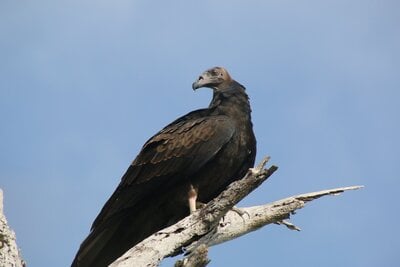image subtitle: is this bird hazardous to your flock?
Perhaps, on a crisp autumn day, you have found yourself sitting outside with your flock. Everything is peaceful until a dark shadow crosses the sky, your heart races- your birds scatter and scream. As a dark bird circles above, no doubt a raptor. You run to check if everyone is ok- they are, but how can you know this will be the same the next time....
Identifying birds of prey can be difficult, but knowing what species pose a threat to your flock is an advantageous skill.
The first thing to know about predatory birds is that under NO CIRCUMSTANCE should a possibly predatory bird be shot. While this might be a tempting way to protect your flock it is both ILLEGAL and hazardous to your local ecosystem. How do know that the bird you just killed wasn't an endangered species hunting to feed its chicks at the last-known nesting site in your state or province? Perhaps it is a lost falconry bird whose owner is now searching in vain? maybe a bird that is part of a migration study- wearing a tracker that will lead right back to you?
shooting raptors isn't worth it.
Now that we have that down, let's talk about what we mean by "raptor"
A "raptor" is any bird that "catches meat with its feet" as well as vultures. While most raptors look similar- they are taxonomically disparate. A falcon is more closely related to a parakeet than to a hawk.
when we speak of raptors- these are the birds we indicate:
Hawks (harriers, buteos, accipiters)
Owls
Eagles
Falcons
Vultures
Kites
Caracaras
osprey
Raptors DO NOT include birds like
Herons
ravens
kingfishers
crows
nightjars
gulls
Since I am focusing on diurnal (day-active) birds that keepers are likely to encounter, I have left owls out of this article. I have also omitted certain very rare species that you are unlikely to ever encounter. I must also mention that the geographic area covered here is from northern Canada to central Mexico- if you are a keeper outside of these areas you are unlikely to encounter the birds listed here. I think this has been a sufficient introduction- so let's dig in!
The vultures:
New-world vultures (colloquially known as "buzzards") such as the black and turkey vulture are massive, intimidating birds. However, unless a member of your flock is in the act of dying, vultures pose no harm. Vultures hold their wings in a V shape and wobble in flight-rarely flapping and often flying low.
The bird in the cover photo (taken by me) is a juvenile turkey vulture , of no harm to any living bird.
Figure one- a turkey vulture (left) and black vulture (right) shown in flight. credits below.


credits- turkey Amanda Guercio, black- Rob Dickerson
The Hawks:
This is where things get trickier. There four classes of hawk within the area this article covers- the harriers, buteos and parabuteos, accipiters. However, out of these, only three individual species will ever cause you problems. These are the red-tailed hawk, the cooper's hawk, and the sharp-shinned hawk.
The red-tailed hawk is a buteo, a common "soaring hawk" that has been recorded everywhere from rainforests to big cities. When the average person says "I saw a hawk" they were probably talking about the red-tail.The red-tailed hawk can cause problems for birdkeepers, as they are known to feed on pigeons, ducks, chickens, and pheasants.
Identifying a red-tailed hawk can be difficult- one of of the best ways to identify one from far off and bring your birds to safety is by learning their main call- a common stand-in for that of an eagle in movies.
Click in the link to listen to the call of a red-tailed hawk:
https://macaulaylibrary.org/asset/229578/embed/640
Identifying the red-tailed hawk by eye is also possible. At great heights, a soaring red-tail has a golden brownish hue to it, but when it comes closer field marks become apparent. the most important field mark for red-tailed hawks is not the red tail (as juveniles and some subspecies lack this) but a patchy stripe found on the breast known as the "belly band"
Figure two- A flying red-tail of the eastern subspecies, note the belly band.

photo credit- Vincent Fyson.
Red-tailed hawks also vary by region- here are a few local forms that may look different than the one pictured above:
Figure three- variations in the red-tailed hawk.




photo credits in order of appearance- Jerry Liguori,Jon G.,Jim Merritt,Darren Clark
Cooper's and Sharp-shinned hawks are two accipiters (forest hawks) that look very similar- and can both be a danger to your flock. The main difference between these species is their size. While the cooper's hawk is (barely) capable of taking prey as large as a chicken, the sharp-shinned struggles to take down a pigeon. Only pigeons and young fowl are in danger from these birds, and even then, records of predation are low.
Figure four- the size difference between a male sharp-shinned hawk on the left and male cooper's hawk on the right.

photo credit-Carolina bird club.
In flight- these two birds are slender-looking with long tails they have earned the name "flying crosses". Adult males have an orangeish breast while females and juveniles have brown streaks. Tails are sometimes fanned to show horizontal bars.
Figure five- Cooper's and sharp-shinned hawks in flight

original source unknown.
With the three common dangerous hawks out of the way, there are a few less common to downright rare species that may also snack on a pigeon or chicken. It is also important to note that these species are rarely known to eat poultry. photos and names listed below.
Figure six: birds that may, but are unlikely to, feed on your flock.






Top row left to right- Northern goshawk, red-shouldered hawk, Harris hawk. bottom row left to right- rough-legged hawk, Swainson's hawk, ferruginous hawk.
credits: Darren Clark, Brad Imhoff, Gates Dupont, Rodney Crice, Darren Clark, Brian Sullivan.
Furthermore, some hawks have never (or in very, very few instances) preyed on poultry. Your flock is safe around the following species:
Figure seven- non-poultry-eating hawks




in order of appearance, northern harrier, broad-winged hawk, common Blackhawk, short-tailed hawk.
credits- Song Yu, Brendan Klick, Blair Dudeck,Caleb Putnam
The osprey is a large hawk-like bird of prey colloquially known as the fish hawk (even though it is taxonomically separate from hawks). True to their colloquial name, the osprey feeds almost solely on fish (occasionally mammals and reptiles). Because of this, the osprey is of no threat to any bird.
Figure eight- two views of an osprey


photos by me.
The divergent group of hawks called the kites have been described as "wind given from" by the field guide author Pete Dune. This epithet fits the graceful, small raptors well as they spend most of their waking hours in what seems to be effortless drifting through the sky. The main prey of the kites are insects, reptiles, rodents, and occasionally small birds. Like the other small raptors, kites are unable to harm any bird larger than a sparrow, unless of course, that bird gets too close to their nest. If a large bird strays too near the nest of the Mississippi kite especially, the "trespassing" bird will be dive-bombed by the angry parents until they get up the sense to move away from the nest.
Figure nine- three species of kite.



right to left- swallow-tailed kite, Mississippi kite, snail kite.
credits- Luke Seitz,Don Danko,Roni Martinez
Eagles are unmistakable for their massive size. the area covered by this article only contains two regularly occurring species -the bald eagle and the golden eagle. The golden eagle very rarely takes avian prey. when it does, this prey is usually comprised of geese. The bald eagle is similar in the fact that it likes to prey on waterfowl, however, the bald eagle is far more opportunistic than the golden, and will eat pretty much anything it can get its talons on (usually ducks and geese, but occasionally other fowl). While livestock attacks from both species are rare, it is important to note that these eagles are opportunistic, and scavengers. if they find something, dead or alive, that they can eat, they will eat it. Because the adult plumage of the bald eagle is unmistakable (white head, white tail, brown body) I have included a photo of a less well-known juvenile.
figure ten- An adult golden eagle left and juvenile bald eagle right.


credits- Miguel Rouco,Blair Dudeck
Falcons are rather small, slim raptors that hunt prey in the air. Due to this, free-flying pigeons are at the highest risk of falcon predation. Of the three common falcons, the merlin, the American kestrel, and the peregrine falcon (known colloquially as the duck hawk, pigeon hawk, and sparrow hawk respectively)- Only the merlin and peregrine falcon are able to hunt pigeons, and only the peregrine is able to hunt birds up to the size of young chickens and ducks.
Figure eleven- three falcon species.



left to right- peregrine falcon, merlin, American kestrel.
credits Samuel Paul Galick,Brandon P.M. Edwards,Michael JD
Caracaras are a branch of falcons that have adapted to an opportunistic, scavenging lifestyle. Caracara eat whatever small animals they can find- dead or alive. one thing caracaras do not eat, however, are birds, meaning that as long as your flock is healthy, it is under no threat from a caracara.
Figure twelve- a pair of crested caracara, the only species regular in this article's region.

photo credit-Paul Kinzer
This review of raptors is simplified, and there are a few more, rare species that exist, but are not seen very often. If you have any questions, feel free to comment!
Perhaps, on a crisp autumn day, you have found yourself sitting outside with your flock. Everything is peaceful until a dark shadow crosses the sky, your heart races- your birds scatter and scream. As a dark bird circles above, no doubt a raptor. You run to check if everyone is ok- they are, but how can you know this will be the same the next time....
Identifying birds of prey can be difficult, but knowing what species pose a threat to your flock is an advantageous skill.
The first thing to know about predatory birds is that under NO CIRCUMSTANCE should a possibly predatory bird be shot. While this might be a tempting way to protect your flock it is both ILLEGAL and hazardous to your local ecosystem. How do know that the bird you just killed wasn't an endangered species hunting to feed its chicks at the last-known nesting site in your state or province? Perhaps it is a lost falconry bird whose owner is now searching in vain? maybe a bird that is part of a migration study- wearing a tracker that will lead right back to you?
shooting raptors isn't worth it.
Now that we have that down, let's talk about what we mean by "raptor"
A "raptor" is any bird that "catches meat with its feet" as well as vultures. While most raptors look similar- they are taxonomically disparate. A falcon is more closely related to a parakeet than to a hawk.
when we speak of raptors- these are the birds we indicate:
Hawks (harriers, buteos, accipiters)
Owls
Eagles
Falcons
Vultures
Kites
Caracaras
osprey
Raptors DO NOT include birds like
Herons
ravens
kingfishers
crows
nightjars
gulls
Since I am focusing on diurnal (day-active) birds that keepers are likely to encounter, I have left owls out of this article. I have also omitted certain very rare species that you are unlikely to ever encounter. I must also mention that the geographic area covered here is from northern Canada to central Mexico- if you are a keeper outside of these areas you are unlikely to encounter the birds listed here. I think this has been a sufficient introduction- so let's dig in!
The vultures:
New-world vultures (colloquially known as "buzzards") such as the black and turkey vulture are massive, intimidating birds. However, unless a member of your flock is in the act of dying, vultures pose no harm. Vultures hold their wings in a V shape and wobble in flight-rarely flapping and often flying low.
The bird in the cover photo (taken by me) is a juvenile turkey vulture , of no harm to any living bird.
Figure one- a turkey vulture (left) and black vulture (right) shown in flight. credits below.
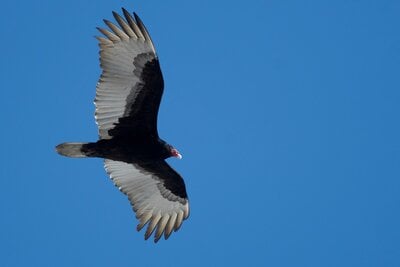
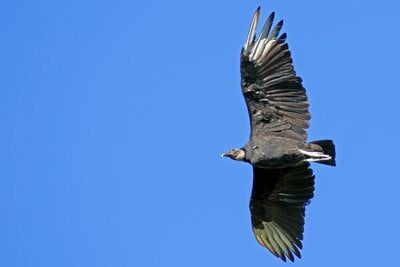
credits- turkey Amanda Guercio, black- Rob Dickerson
The Hawks:
This is where things get trickier. There four classes of hawk within the area this article covers- the harriers, buteos and parabuteos, accipiters. However, out of these, only three individual species will ever cause you problems. These are the red-tailed hawk, the cooper's hawk, and the sharp-shinned hawk.
The red-tailed hawk is a buteo, a common "soaring hawk" that has been recorded everywhere from rainforests to big cities. When the average person says "I saw a hawk" they were probably talking about the red-tail.The red-tailed hawk can cause problems for birdkeepers, as they are known to feed on pigeons, ducks, chickens, and pheasants.
Identifying a red-tailed hawk can be difficult- one of of the best ways to identify one from far off and bring your birds to safety is by learning their main call- a common stand-in for that of an eagle in movies.
Click in the link to listen to the call of a red-tailed hawk:
https://macaulaylibrary.org/asset/229578/embed/640
Identifying the red-tailed hawk by eye is also possible. At great heights, a soaring red-tail has a golden brownish hue to it, but when it comes closer field marks become apparent. the most important field mark for red-tailed hawks is not the red tail (as juveniles and some subspecies lack this) but a patchy stripe found on the breast known as the "belly band"
Figure two- A flying red-tail of the eastern subspecies, note the belly band.
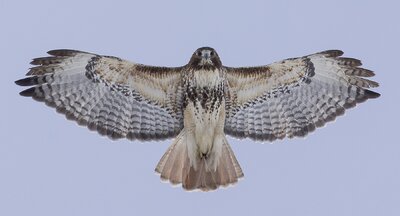
photo credit- Vincent Fyson.
Red-tailed hawks also vary by region- here are a few local forms that may look different than the one pictured above:
Figure three- variations in the red-tailed hawk.
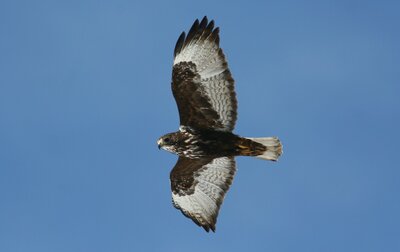
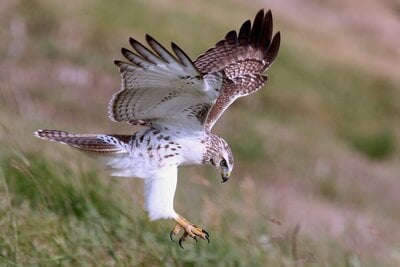
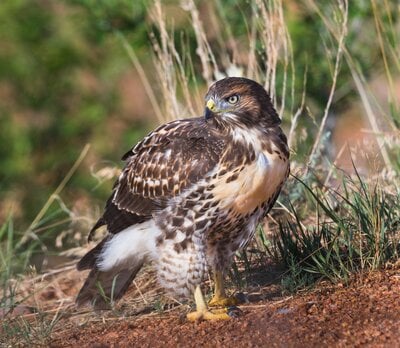
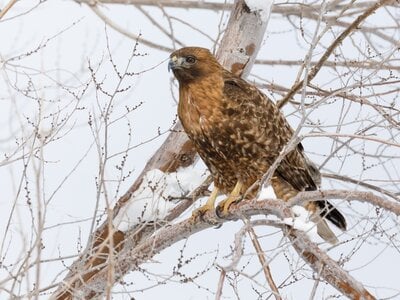
photo credits in order of appearance- Jerry Liguori,Jon G.,Jim Merritt,Darren Clark
Cooper's and Sharp-shinned hawks are two accipiters (forest hawks) that look very similar- and can both be a danger to your flock. The main difference between these species is their size. While the cooper's hawk is (barely) capable of taking prey as large as a chicken, the sharp-shinned struggles to take down a pigeon. Only pigeons and young fowl are in danger from these birds, and even then, records of predation are low.
Figure four- the size difference between a male sharp-shinned hawk on the left and male cooper's hawk on the right.
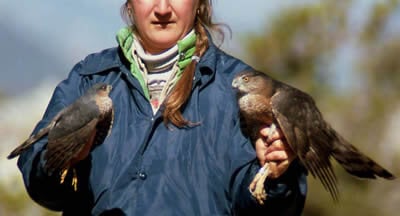
photo credit-Carolina bird club.
In flight- these two birds are slender-looking with long tails they have earned the name "flying crosses". Adult males have an orangeish breast while females and juveniles have brown streaks. Tails are sometimes fanned to show horizontal bars.
Figure five- Cooper's and sharp-shinned hawks in flight
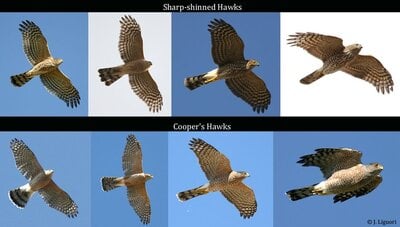
original source unknown.
With the three common dangerous hawks out of the way, there are a few less common to downright rare species that may also snack on a pigeon or chicken. It is also important to note that these species are rarely known to eat poultry. photos and names listed below.
Figure six: birds that may, but are unlikely to, feed on your flock.
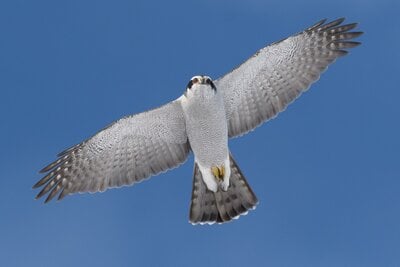
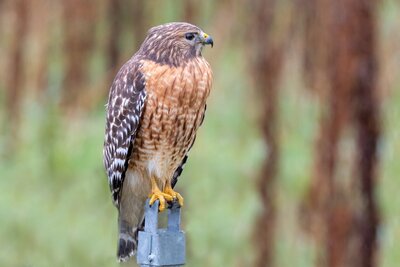
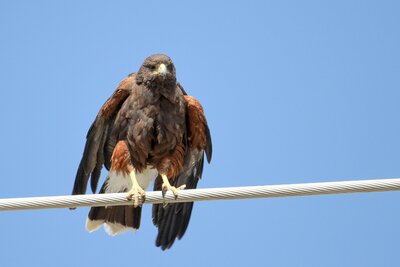
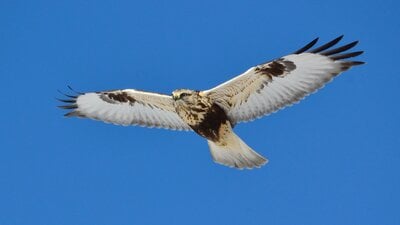
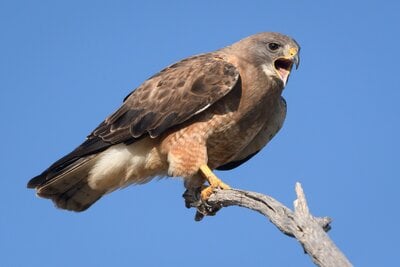
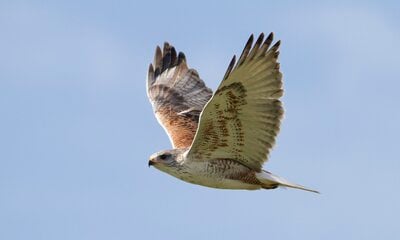
Top row left to right- Northern goshawk, red-shouldered hawk, Harris hawk. bottom row left to right- rough-legged hawk, Swainson's hawk, ferruginous hawk.
credits: Darren Clark, Brad Imhoff, Gates Dupont, Rodney Crice, Darren Clark, Brian Sullivan.
Furthermore, some hawks have never (or in very, very few instances) preyed on poultry. Your flock is safe around the following species:
Figure seven- non-poultry-eating hawks
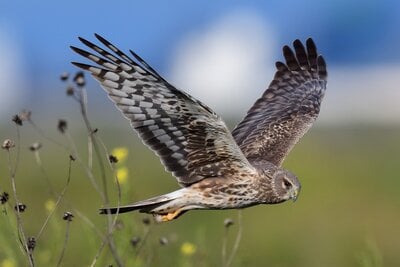
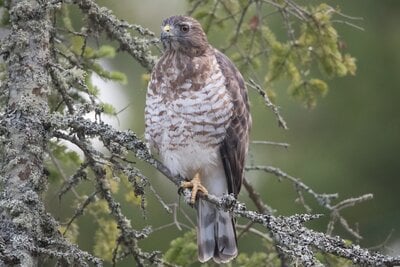
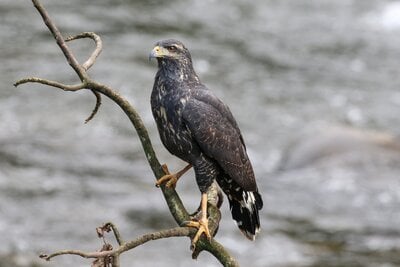
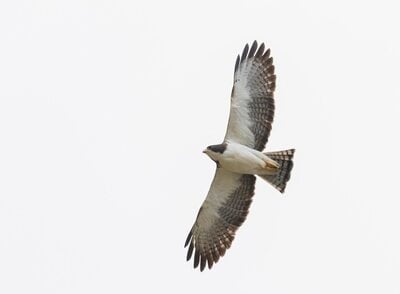
in order of appearance, northern harrier, broad-winged hawk, common Blackhawk, short-tailed hawk.
credits- Song Yu, Brendan Klick, Blair Dudeck,Caleb Putnam
The osprey is a large hawk-like bird of prey colloquially known as the fish hawk (even though it is taxonomically separate from hawks). True to their colloquial name, the osprey feeds almost solely on fish (occasionally mammals and reptiles). Because of this, the osprey is of no threat to any bird.
Figure eight- two views of an osprey
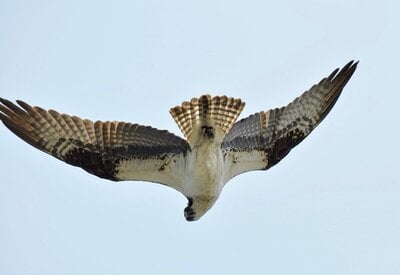
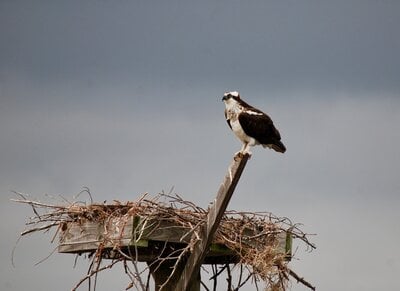
photos by me.
The divergent group of hawks called the kites have been described as "wind given from" by the field guide author Pete Dune. This epithet fits the graceful, small raptors well as they spend most of their waking hours in what seems to be effortless drifting through the sky. The main prey of the kites are insects, reptiles, rodents, and occasionally small birds. Like the other small raptors, kites are unable to harm any bird larger than a sparrow, unless of course, that bird gets too close to their nest. If a large bird strays too near the nest of the Mississippi kite especially, the "trespassing" bird will be dive-bombed by the angry parents until they get up the sense to move away from the nest.
Figure nine- three species of kite.
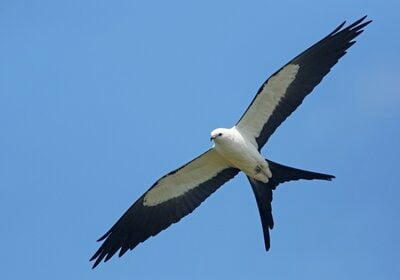
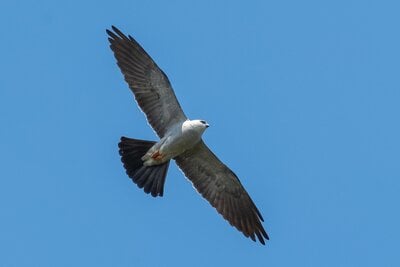
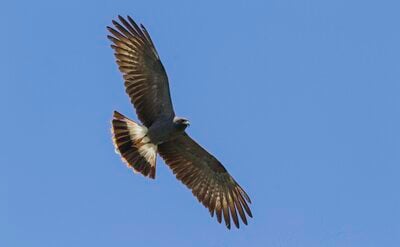
right to left- swallow-tailed kite, Mississippi kite, snail kite.
credits- Luke Seitz,Don Danko,Roni Martinez
Eagles are unmistakable for their massive size. the area covered by this article only contains two regularly occurring species -the bald eagle and the golden eagle. The golden eagle very rarely takes avian prey. when it does, this prey is usually comprised of geese. The bald eagle is similar in the fact that it likes to prey on waterfowl, however, the bald eagle is far more opportunistic than the golden, and will eat pretty much anything it can get its talons on (usually ducks and geese, but occasionally other fowl). While livestock attacks from both species are rare, it is important to note that these eagles are opportunistic, and scavengers. if they find something, dead or alive, that they can eat, they will eat it. Because the adult plumage of the bald eagle is unmistakable (white head, white tail, brown body) I have included a photo of a less well-known juvenile.
figure ten- An adult golden eagle left and juvenile bald eagle right.
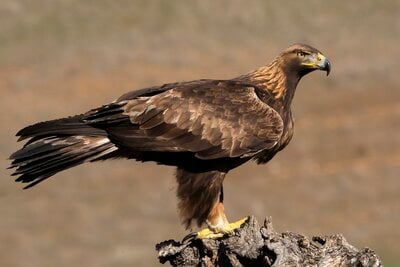
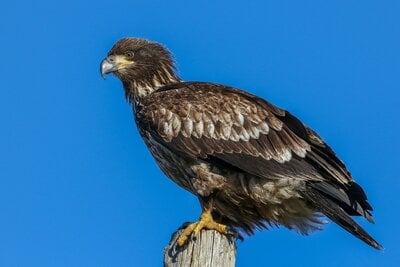
credits- Miguel Rouco,Blair Dudeck
Falcons are rather small, slim raptors that hunt prey in the air. Due to this, free-flying pigeons are at the highest risk of falcon predation. Of the three common falcons, the merlin, the American kestrel, and the peregrine falcon (known colloquially as the duck hawk, pigeon hawk, and sparrow hawk respectively)- Only the merlin and peregrine falcon are able to hunt pigeons, and only the peregrine is able to hunt birds up to the size of young chickens and ducks.
Figure eleven- three falcon species.
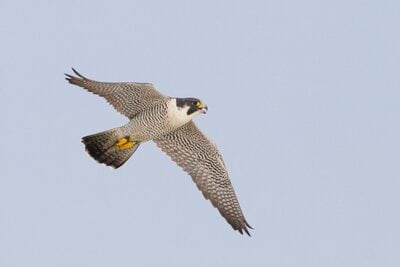
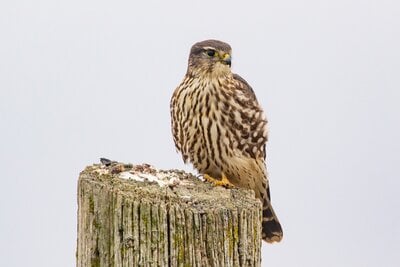
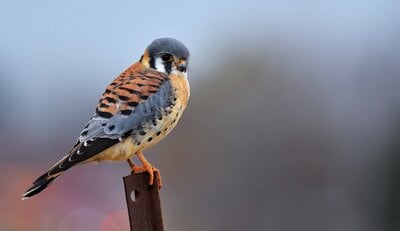
left to right- peregrine falcon, merlin, American kestrel.
credits Samuel Paul Galick,Brandon P.M. Edwards,Michael JD
Caracaras are a branch of falcons that have adapted to an opportunistic, scavenging lifestyle. Caracara eat whatever small animals they can find- dead or alive. one thing caracaras do not eat, however, are birds, meaning that as long as your flock is healthy, it is under no threat from a caracara.
Figure twelve- a pair of crested caracara, the only species regular in this article's region.
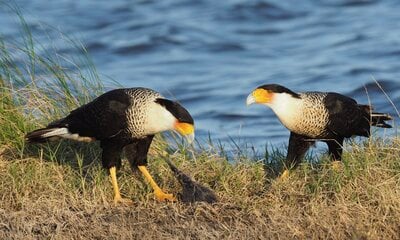
photo credit-Paul Kinzer
This review of raptors is simplified, and there are a few more, rare species that exist, but are not seen very often. If you have any questions, feel free to comment!

